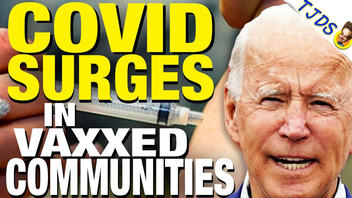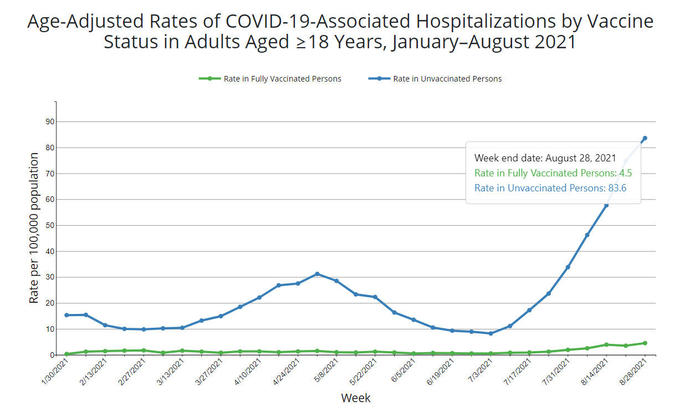
Did a Harvard study show that a large number of countries and U.S. counties with high vaccination rates may have higher rates of COVID-19 infection than places with low vaccination rates, and is the vaccination rate the cause? No, that's not true: A letter to the editor written by Harvard professor S.V. Subramanian and a high school student was posted as an "online first article" by the European Journal of Epidemiology.
They found "that there appears to be no discernible relationship between the percentage of population fully vaccinated and new COVID-19 cases in the last seven days." Several articles presented this correspondence as proof of a failure of the vaccines. Then, in an email to a Mother Jones reporter, Subramanian clarified, "Other research has clearly and definitively established that the vaccines significantly reduce the risk of hospitalization and mortality."
The root of the claims is correspondence from Subramanian, a Harvard professor of population health and geography, posted by the European Journal of Epidemiology on September 30, 2021. This correspondence has served as a talking point and has been misrepresented in many articles, blogs and videos. One example of this is a video (archived here) published on YouTube by "The Jimmy Dore Show" on October 17, 2021, under the title "Covid SURGES Among Most Vaxxed Communities Says Harvard Study." At 0:35 into the video Dore says:
Well there's a paper out now. A study from Harvard. So there it is -- it says 'Increases in COVID-19 are unrelated to levels of vaccination across 68 countries and 2,947 counties in the United States.' There's the people who did the study and it's printed in the European Journal of Epidemiology. It's also, so there's from the Harvard Center of Population and Development Studies Cambridge Massachusetts the Department of Social and Behavioral Sciences Harvard T.H. Chan School of Public Health Boston met and then the Turner Fenton Secondary School, Brampton Ontario Canada. So it's also, this article's also been printed at the nih.gov -- there it is, OK? And that is the United States National Library of Medicine, National Institutes of Health, OK?
Click below to watch the video on YouTube:
In Dore's introduction he mentions the Harvard centers and departmental affiliations of Subramanian and also mentions Turner Fenton Secondary School, a high school in Toronto where co-author Akhil Kumar is a student. He is active with Harvard's Erevna student research program, notably as the managing director of the Coronavirus Visualization Community. In an instance of erroneously applied credentials, Akhil Kumar is misidentified as a Penn State professor in an article published by nationalfile.com on October 18, 2021. While there is a Penn State professor by the same name, he is a professor of information systems -- not a high school student. They are not the same person.
Springer.com is a publisher of many books and journals, including the European Journal of Epidemiology. The article is classified as correspondence, is published as an online-first article and is not included in the journal's list of topics in Volume 36, issue 9, of September 2021. Lead Stories reached out to Springer Nature by email to find out if this correspondence had been peer-reviewed. Press officer Deborah Kendall-Cheeseman replied on October 20, 2021, explaining:
The paper was peer reviewed and was submitted and published as a Letter to the Editor. We are aware that concerns have been raised regarding the paper and they are currently being considered carefully.
Dore emphasizes the article is printed at nih.gov. This misrepresents the agency's PubMed site as a publisher rather than a library. There is a detailed disclaimer page that explains:
Once publications are selected for inclusion in a database, NLM does not review, evaluate, or judge the quality of individual articles and relies on the scientific publishing process to identify and address problems through published comments, corrections, and retractions (or, as in the case of preprints, withdrawal notices). The publisher is responsible for maintaining the currency of the scientific record and depositing all relevant updates to the appropriate NLM database.
NLM literature databases also archive and index articles, author manuscripts, and book chapters that may be from publications that have not yet undergone scientific review by NLM, are traditionally out of scope for the NLM collection, or have not met NLM's standards for inclusion in a given NLM literature databases also archive and index articles, author manuscripts, and book chapters that may be from publications that have not yet undergone scientific review by NLM, are traditionally out of scope for the NLM collection, or have not met NLM's standards for inclusion in a given database ...
At 1:32 in the video Dore continues reading from the letter, sometimes adding his own emphasis:
Now this is something that the guys at The Intercept would look at and think it was crazy. They don't understand science. It's OK, so what does this study say? What did they find out? At the country level there appears to be no discernible relationship between percentage of population fully vaccinated and new COVID-19 cases. What? Huh? In fact -- hold on to your hats -- in fact the trend line suggests that countries with higher percentage of population fully vaccinated have higher COVID-19 cases per 1 million people. Uh-oh! Notably Israel with over 60 percent of their population fully vaccinated had the highest COVID-19 cases per 1 million people in the last seven days. The lack of meaningful association between percentage population fully vaccinated and new COVID-19 cases is further exemplified for instance by comparison of Iceland and Portugal. Both countries have over 75 percent of their population fully vaccinated and have more COVID-19 cases per 1 million people than countries such as Vietnam and South Africa that have around 10 percent of their population fully vaccinated.
Lead Stories reached out by email to Katelyn Jetelina, an epidemiologist at the University of Texas Health Science Center, School of Public Health, to get a better understanding of what these findings illustrate. She replied on October 20, 2021, explaining:
I largely agree with the author's conclusion: 'The sole reliance on vaccination as a primary strategy to mitigate COVID19 and its adverse consequences needs to be re-examined'. If we only vaccinate 60% of the population, that leaves a lot of people left for the virus to infect. We can't rely on vaccines to protect entire populations until we reach a high enough rate (like 90% for COVID19). Until then, we are going to continue to see pockets of unprotected individuals infected. The problem is that this has been taken out of context. This doesn't mean that vaccines don't work. It means that we need a combination of measures until we have a strong enough immunity wall (i.e. herd immunity) for all.
A Mother Jones article published on October 12, 2021, titled, "A Harvard Study Is Going Viral Among Anti-Vaxxers. The Author Says They Are All Wrong." invited Subramanian to respond to published reactions to his letter. Mentioned in the Mother Jones article were a tweet and article by The Blaze titled, "Horowitz: Harvard researcher finds absolutely no correlation between vax rates and COVID cases globally." By way of email, Subramanian clarified to Mother Jones:
This paper supports vaccination as an important strategy for reducing infection and transmission, along with hand-washing, mask-wearing, and physical distancing.
And:
Other research has clearly and definitively established that the vaccines significantly reduce the risk of hospitalization and mortality.
The Centers for Disease Control and Prevention continues to measure vaccine effectiveness. There is a COVID Data Tracker page with information comparing the rates of hospitalization among vaccinated and unvaccinated adults ending the week of August 28, 2021. This chart shows that the rate of COVID-19 associated hospitalizations per 100,000 people that week was 4.5 for vaccinated people and 83.6 for unvaccinated people. Additional charts on the page show the information broken down by age groups.
(Image source CDC COVID Data Tracker screenshot taken on Tue Oct 19 14:34:40 2021 UTC)

















